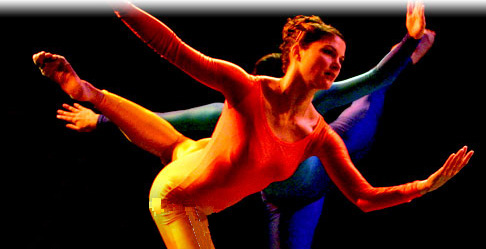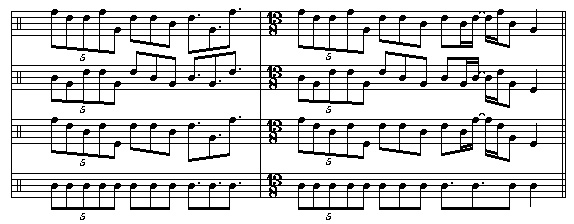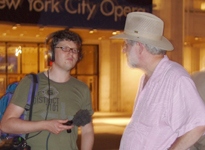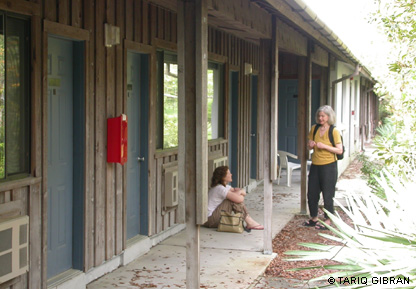Musico-scientific omnivore Brian McLaren points me to an interview with Malcolm Gladwell that debunks the significance of child prodigies. Gladwell was a child prodigy athlete who, as a teenager, found that his native talent was actually little better than mediocre. Becoming fascinated by the phenomenon, he studied it and found that the correspondence between remarkable early achievement and adult success in a field is actually almost statistically insignificant:
…the young Mozart’s prowess can be chalked up to practice, practice, practice. Compelled to practice three hours a day from age three on, by age six the young Wolfgang had logged an astonishing 3,500 hours — “three times more than anybody else in his peer group. No wonder they thought he was a genius.” So Mozart’s famous precociousness as a musician was not innate musical ability but rather his ability to work hard, and circumstances (i.e., his father) that pushed him to do so.
“That is a very different definition of precociousness than I think the one that we generally deal with.”
A better poster child for what precociousness really entails, Gladwell hinted, may thus be the famous intellectual late-bloomer, Einstein. Gladwell cited a biographer’s description of the future physicist, who displayed no remarkable native intelligence as a child but whose success seems to have derived from certain habits and personality traits — curiosity, doggedness, determinedness — that are the less glamorous but perhaps more essential components of genius.
The classical music world would do well to keep this in mind. We have a lot of brilliant composers going unperformed because their breakthrough came in their ’40s – while we are relentlessly subjected to lousy music by composers who wrote a seemingly precocious piece once in grad school. Penderecki comes to mind – has he written anything worth sitting through since the ’60s? And was his Threnody, penned at 26, anything more than a frisson of novel sounds? Therefore we are subjected to his uninsightful conservative mimickry, his pseudo-portentous Lisztian paeans to the chromatic scale, forever, as he racks up music awards a handful at a time? In classical music, precocity is an ironclad predictor of adult success – only because no one ever notices if you don’t live up to your early promise.
I actually had an experience similar to Gladwell’s. I was the “math genius” of my high school. I would occasionally look at an algebra problem and the correct answer would fly into my head, after which I’d have to work it out and prove it was correct. I’d catch my trigonometry teacher’s mistakes. My teachers all urged me to go into math until I got into calculus, where it abruptly became apparent that my talent for all higher-level math was pedestrian at best. (Turns out, the math I had facility in was exactly the type needed for working in just intonation.) The difference between me and some of our Pulitzer hacks is that I am not enabled to inflict my mathematical expertise on the world just because of some deceptive early successes.
(By the way, don’t just take my word on Penderecki. Even his bio in Grove Dictionary expresses doubts: “In 1998 he wrote in a foreword to a catalogue of his sketches that he felt he was getting close to the essence of music. By implication, these views are somewhat dismissive of his music of the 1960s, arguably his most distinctive contribution to 20th-century culture. Penderecki is a composer who has consistently engaged with the issues of the outside world, sometimes with piety, often with apparent anger and never without passion. Nevertheless, his stylistic shifts have often raised more questions than answers.”)

 The dancers were forming and reforming in pairs, and wore elastic bands that they would tie each other together with intermittently. Forgive me for not describing more: dance is the most difficult art form for me to grasp, and I’ve never had any vocabulary for it. It looked like the picture.
The dancers were forming and reforming in pairs, and wore elastic bands that they would tie each other together with intermittently. Forgive me for not describing more: dance is the most difficult art form for me to grasp, and I’ve never had any vocabulary for it. It looked like the picture.

 I am going to be the composer-in-residence at the Atlantic Center for the Arts next February 19 through March 11, down in New Smyrna Beach, Florida. (February and March in Florida, can you imagine? I saw the location and accepted before I knew what it was they wanted me to do.) Composers are invited to apply to come hang out with me and be Associate Artists, meeting for at least two hours a day. The rest of the time, we’ll work on our own projects; I’ll be writing a Concerto for Piano and Winds commissioned by pianist Geoffrey Madge and the Orkest de Volharding. Poet Marie Ponsot and architect Steve Badanes are the other artists who’ll be in residence. The application deadline is Ives’s birthday, October 20. I am told by a former Associate that it’s a good idea to advertise this on my blog, to get the word out so people
I am going to be the composer-in-residence at the Atlantic Center for the Arts next February 19 through March 11, down in New Smyrna Beach, Florida. (February and March in Florida, can you imagine? I saw the location and accepted before I knew what it was they wanted me to do.) Composers are invited to apply to come hang out with me and be Associate Artists, meeting for at least two hours a day. The rest of the time, we’ll work on our own projects; I’ll be writing a Concerto for Piano and Winds commissioned by pianist Geoffrey Madge and the Orkest de Volharding. Poet Marie Ponsot and architect Steve Badanes are the other artists who’ll be in residence. The application deadline is Ives’s birthday, October 20. I am told by a former Associate that it’s a good idea to advertise this on my blog, to get the word out so people